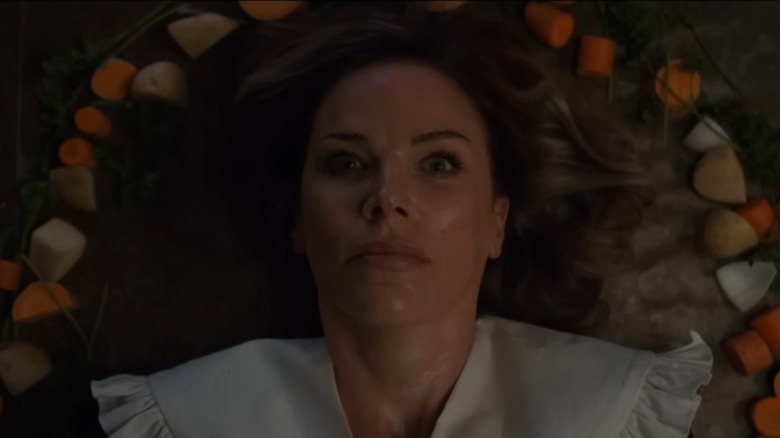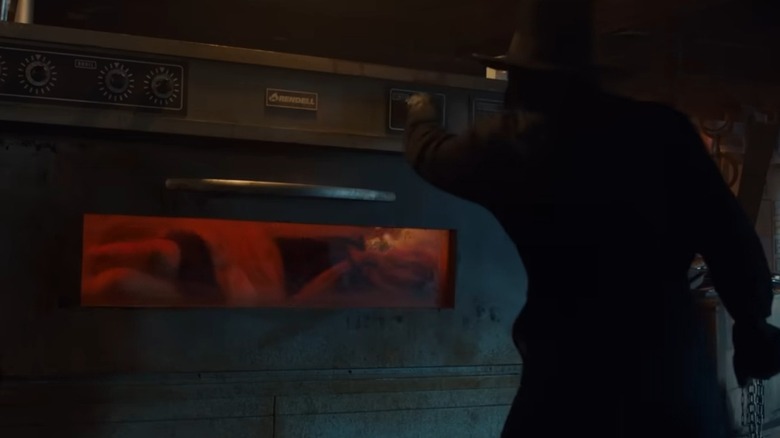Eli Roth Wanted To Evolve Beyond Edgelord Horror With Thanksgiving
Filmmaker Eli Roth exploded onto the horror scene in 2002 with the ultra-gory, deliberately shocking virus movie "Cabin Fever," a film so goopy and gross, it all but assured Roth a place in the contemporary horror canon of rising filmmakers. His snarky, shock-for-shock's-sake fratboy mentality fit perfectly in with the "extreme" edgelord attitudes of the early '00s. Indeed, some might say that it was Roth's films that helped define the era's impish, adolescent propensity toward provocation. The director certainly cemented his legacy as one of the key figures in the post-9/11 "torture porn" subgenre with his two "Hostel" movies in 2005 and 2007. He pushed his legacy further in 2013 with the release of "The Green Inferno," an homage to extreme 1980s Italian cannibal movies like "Cannibal Holocaust." Roth was a "bad boy."
In 2007, Roth made a jokey trailer for a fake slasher movie called "Thanksgiving," a trailer included in the Robert Rodriguez/Quentin Tarantino double feature "Grindhouse." The fake trailer was clearly a sendup of early-'80s "Halloween" knockoffs and featured silly, exploitative, ultra-violent murders with a Thanksgiving theme. Fast-forward to 2023, and Roth has made "Thanksgiving" into a real feature film, due in theaters on November 17.
But, it seems that Roth didn't want to make the real "Thanksgiving" to be as trashy as his 2007 fake preview made it look. At least, he wanted it to be trashy in a new, updated way. What was shocking in 2007 won't read the same in 2023. The filmmaker, now 51, wanted "Thanksgiving" to invent new ways to appall audiences. He said as much in an interview printed in the latest issue of Total Film Magazine.
Nudity and exploitation cinema in 2023
It should be noted that the 2007 preview for "Thanksgiving" featured R-rated gore and nudity that were rarely seen in previews outside of 1970s grindhouse theaters and drive-ins. There was a notorious scene wherein a teenage cheerleader (Vendula Bednarova) removes her blouse while bouncing on a trampoline, before landing in a splits position onto a knife stabbed through the trampoline from below. It's a deliberately gross scene, and one that Roth acknowledges isn't something he would do today. When asked about the nature of old-fashioned sexploitation in 2023, Roth said:
"You better have a good reason for it, because it's going to have different connotations in 2023. [...] Look, I've been the guy that made something that was offensive and exploitative for the sake of being shocking. I've had that experience. So I wanted to make a movie that was fun for everybody."
Exploitation cinema, of course, has a vital place in the history of the medium, and any number of snotty essayists (like this author) could wax rhapsodic about the lizard-brain necessity of sex and violence on camera. But there's a difference between being tasteless and being distasteful. Hence Roth's "fun for everybody" comment. Distasteful violence is violence that possesses an element of hate or dismay toward the victims, with filmmakers who are obviously being cruel to innocent characters for the sake of it. Tasteless violence, to differentiate, is clearly meant to be trashy entertainment, but is presented by a wise filmmaker who has a genuine, enthused interest in wild horror movies ... and the raucous party atmosphere they can engender.
Some violence can be too extreme to be part of the party. Other acts of violence are cartoony and unreal enough to inspire hooting, hollering, and brief breaks in theater make-outs.
Shocking in a different way
Of course, Roth would be happy to be described as "distasteful," an adjective he applies to himself. Roth wanted to assure readers, however, that he was certainly not shying away from extremity. Although the filmmaker did make a kid-friendly film in 2018 ("The House with a Clock in Its Walls"), he hasn't lost sight of how much fun horror movie violence can be, nor how bloody and off-putting he can get. He said:
"So the trick, for me, was to come up with: 'What is shocking in a different way?' I don't want anyone to think my work is sanitized, because it's certainly not. But how can I surprise people, and be distasteful and offensive in a way they don't see coming? And I think that we did it."
"Creatively distasteful" might be a good axiomatic phrase more horror filmmakers might adopt. Regardless, Roth seems to have grown since 2013, when he was quoted in the Los Angeles Times describing "The Green Inferno" as an anti-SJW movie. "Inferno" is a hateful movie that clearly loathes college student activists to the point of feeling them to Amazonian cannibals. He said:
"Everyone got so self-righteous and publicly shaming [over] something that they hadn't heard of 24 hours ago. I think it's a double-edged sword. I think there are ways to get involved and ways to be helpful. But the SJW culture has gotten so out of control. That you feel that everyone ... are they doing it because they believe in it? Or do they just want to look like good people? ... I'm just making a comment on it."
Perhaps the need to karmically punish people Roth hates personally has been ejected from his system, and the blood can flow from a purer place.


